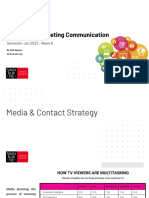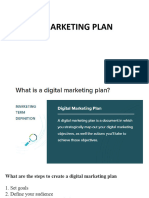0% found this document useful (0 votes)
4 views27 pagesModule 12-5.a
The document outlines a digital and social media strategy course led by Jamie Turner, covering topics such as analytics, media planning, and customer acquisition costs. It emphasizes the importance of understanding buyer personas, setting SMART goals, and conducting competitive analyses to inform media strategies. Additionally, it provides a structured approach to calculating customer acquisition costs and developing a comprehensive media plan for digital marketing campaigns.
Uploaded by
vanshCopyright
© © All Rights Reserved
We take content rights seriously. If you suspect this is your content, claim it here.
Available Formats
Download as PDF, TXT or read online on Scribd
0% found this document useful (0 votes)
4 views27 pagesModule 12-5.a
The document outlines a digital and social media strategy course led by Jamie Turner, covering topics such as analytics, media planning, and customer acquisition costs. It emphasizes the importance of understanding buyer personas, setting SMART goals, and conducting competitive analyses to inform media strategies. Additionally, it provides a structured approach to calculating customer acquisition costs and developing a comprehensive media plan for digital marketing campaigns.
Uploaded by
vanshCopyright
© © All Rights Reserved
We take content rights seriously. If you suspect this is your content, claim it here.
Available Formats
Download as PDF, TXT or read online on Scribd
/ 27
























































































